APPEAL OF EMBREY’S MARKETS STARTS WITH HIGH GROWTH PART 2 – THE EASTERN MARKETS
Prepared by: Jeanette I. Rice, CRE, Rice Economics, LLC
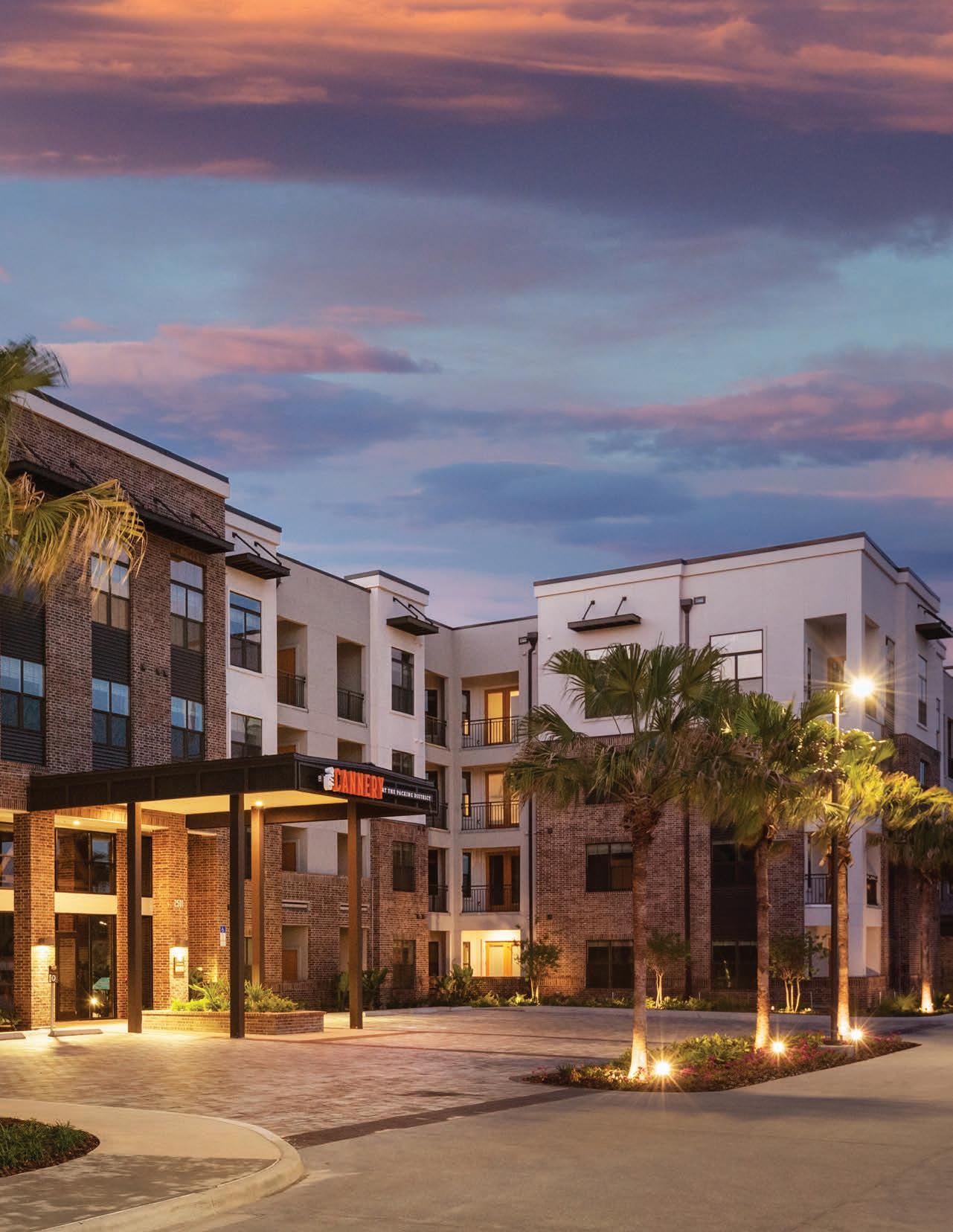

EMBREY’s development and acquisition activity is focused on 11 metropolitan areas: eight where the company is already active — Dallas/Fort Worth, Denver, Phoenix, San Antonio, Austin, Charlotte, Nashville, and Orlando — and three likely expansion markets: Salt Lake City, Raleigh, and Tampa.
The western markets — those in Texas and farther west — were discussed in Appeal of EMBREY’s Markets Starts with High Growth whitepaper published April 2023 ( https://www.embreydc.com/whitepapers/). The discussion below focuses on EMBREY’s eastern markets: Charlotte, Nashville, and Orlando, where EMBREY is currently active, plus Raleigh and Tampa.
EMBREY’s metro markets have been carefully chosen for their potential for healthy long-term market performance and favorable financial returns. Five general characteristics summarize the appeal of the five eastern markets for development and acquisition — paralleling the story of the western markets. Four characteristics — robust population growth, healthy employment expansion, significant high-tech evolution, and notable quality-of-life characteristics — capture the key multifamily demand drivers. The fifth characteristic is strong investor interest.
This report includes a summary of current market performance and near-term outlook for the five eastern markets. Some of the unique economic drivers, quality-of-life features, and development strategies of individual markets are also discussed.
While elevated construction activity in 2022-2023 will moderate market performance in the short term, thereby keeping rent growth at modest levels this year and next, the long-term outlook for all EMBREY’s eastern markets is highly favorable.
| 3 |
FIVE MARKET CHARACTERISTICS CREATE MARKET AND INVESTMENT APPEAL 5
DEMOGRAPHICS: ROBUST POPULATION GROWTH
Robust population growth is a key driver of multifamily demand in all EMBREY’s eastern markets. Population gains have been extraordinarily high over the past few decades and are expected to continue to significantly outpace the nation in the years to come.
From 2010 to 2022 total population in the five metros combined rose by 23.8%, three times the national rate ( FIGURE 1 ). Collectively, the five metros added over 2.5 million people during the past 12 years. All metros ranked among the top 20 in the U.S. for total population gain in the period. Orlando had the largest gain with 630,000 new residents.
Growth rates ranged from Tampa’s 18.2% — more than twice the U.S. average — to Orlando’s 29.5%. Orlando’s increase was nearly four times the national rate and was second highest among major metros (after Austin). Each EMBREY eastern market ranked among the top 13 for growth rate.
Most other Southeast markets outpaced the U.S. in population growth, but to a lesser extent than EMBREY’s five eastern markets. The only other Southeast metros with a comparable growth story are Atlanta and Jacksonville. In the 2010-2022 period, Atlanta’s population rose 17.7% to 6.2 million. Jacksonville’s population climbed 24.4% to 1.7 million.
A large portion of the population gains in EMBREY’s eastern markets comes from in-migration. Inmigration is particularly powerful for creating multifamily demand since individuals and families moving into an area have an immediate need for housing. In the 2010-2020 period, net migration (new residents less residents moving out) totaled 1.6 million or 78.5% of the total population gain of 2.1 million. A significant portion of the new residents in EMBREY’s eastern markets have been moving from the higher-cost and/or less dynamic Northeastern and Midwestern metros, a trend which began long before COVID.
1 | 4 |
SOURCE: EMBREY Partners; Rice Economics, LLC; U.S. Census Bureau. Percent increase rank among 55 metros with at leat one million population in 2022. Raleigh represents Raleigh MSA and Durham MSA.
U.S. 333,288,000 24,542,000 - 7.9Major U.S. Metros 190,644,000 17,095,000 - 9.9Eastern EMBREY Markets 13,006,000 2,504,000 - 23.8Charlotte 2,756,000 512,000 12 22.8 9 Nashville 2,047,000 401,000 17 24.4 6 Orlando 2,764,000 630,000 8 29.5 2 Raleigh 2,149,000 454,000 15 26.8 3 Tampa 3,291,000 507,000 13 18.2 13 METRO 2022 TOTAL 2010-2021 INCREASE NUMBER PERCENT U.S. RANK U.S. RANK
FIGURE 1 POPULATION GROWTH IN EASTERN EMBREY MARKETS, 2010-2022
Population in most of EMBREY’s eastern markets is relatively young, a demographic benefit for creating multifamily demand. A younger population is testimony to the metros’ ability to attract and retain young adults. Every metro, except Tampa, has a lower median age than the national average ( FIGURE 2 ). The percentage of population in prime renter years is higher than the national average in Nashville, Orlando, and Raleigh and on par with the U.S. in Charlotte.
RENTER AGE DEMOGRAPHICS IN WESTERN EMBREY MARKETS, 2022
Population in most of EMBREY’s eastern markets is relatively young, a demographic benefit for creating multifamily demand.
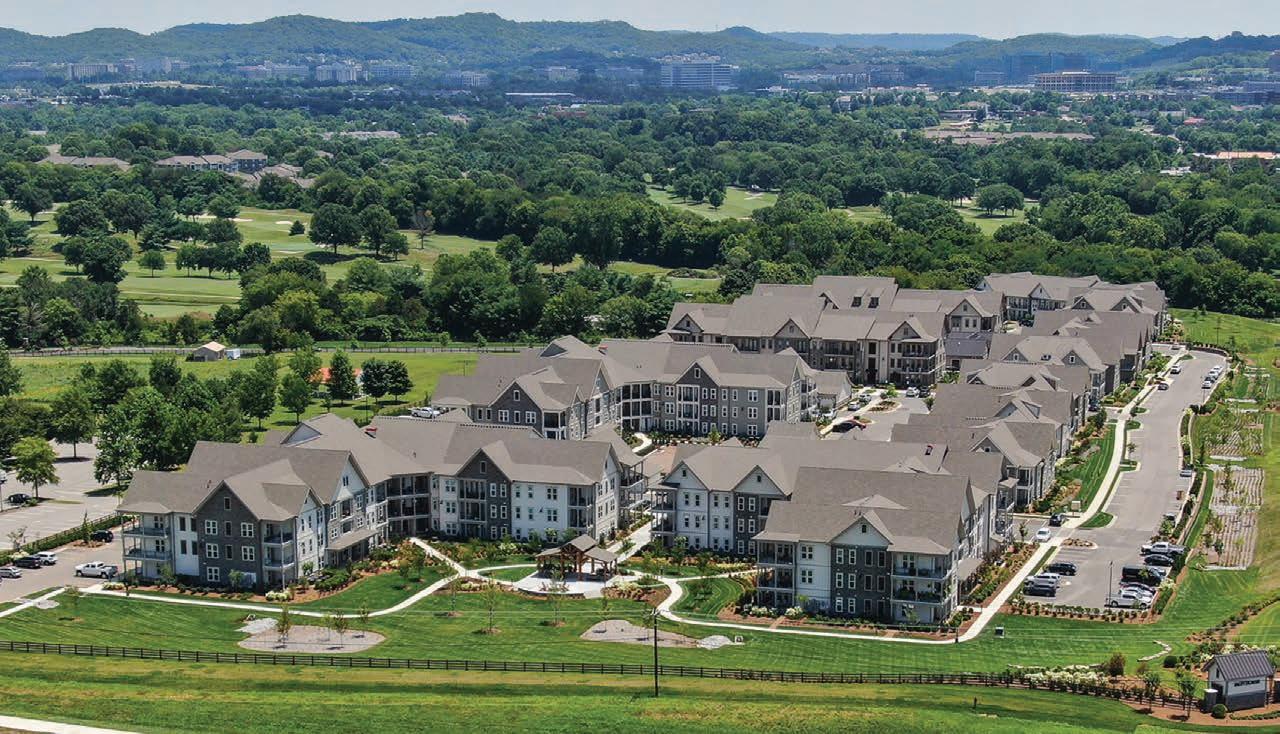 FIGURE 2
FIGURE 2
U.S. 38.8 67,019,000 20.2 EMBREY Eastern Markets 39.0 2,593,000 20.4 EMBREY Eastern Markets x. TAMPA 37.9 1,994,000 21.0 Charlotte 38.1 544,000 20.1 Nashville 37.0 440,000 21.9 Orlando 38.3 572,000 21.3 Raleigh 37.8 438,000 20.8 Tampa 42.4 599,000 18.6
METRO
MEDIAN AGE POPULATION AGED 20-34 (PRIME RENTER AGES) PERCENT OF TOTAL | 5 |
SOURCE: EMBREY Partners; Rice Economics, LLC; U.S. Census Bureau, based on 2022 population. Raleigh represents Raleigh MSA and Durham MSA.
RETREAT AT IRON HORSE | Franklin, TN
EMPLOYMENT: HEALTHY JOB CREATION
Employment growth contributes significantly to multifamily demand. High rates of job creation attract newcomers to a region and keep current residents from seeking employment outside the region. A healthy labor market increases consumer confidence. These trends translate into higher levels of household formation. EMBREY’s eastern markets have all experienced excellent employment expansion over the past decade (COVID aside) and are well positioned to continue to do so.
EMBREY’s eastern markets are experiencing impressive employment gains, with total jobs rising 3.5% over the past year, well above the national rate of 2.6%.
Recent labor statistics illustrate the favorable economic health of EMBREY’s eastern markets ( FIGURE 3 ). The five metros combined added 218,900 jobs in the year ending April 2023 for a 3.5% gain compared to the national 2.6% growth rate — which is itself quite healthy. Orlando and Nashville, followed closely by Tampa, experienced the highest job growth rates of the five markets.
Raleigh MSA and Durham MSA.
Unemployment in the five eastern markets remains very low. April unemployment ranged between 2.1% and 2.9%, all under the national average and all at or nea r historical lows. The eastern markets recovered quicker than the nation in the post-COVID period, fur ther exemplifying the strength of their economies. Among U.S. metros Orlando’s economy was particularly hard hit initially by the pullback in tourism due to the pandemic in 2020. However, by March 2021, Orlando’s unemployment rate had dropped under the national rate and today is one of the lowest in the U.S.
HIGH-TECH: DRAMATIC GROWTH OF DIVERSIFIED HIGH-TECH SECTORS
EMBREY’S five eastern markets have a diverse set of major indust ry concentrations. They range from tourism in Orlando to banking in Charlotte to music entert ainment in Nashville. But a common denominator fueling economic expansion is high tech. High-techn ology industries will also help secure substantial economic growth in the years to come.
 FIGURE 3
FIGURE 3
U.S. 3,937,000 2.6 - 3.1 Major Metros 2,231,400 2.4 -Eastern EMBREY Markets 218,900 3.5 - 2.5 Charlotte 35,600 2.7 20 2.9 Nashville 44,000 4.0 8 2.1 Orlando 55,500 4.0 7 2.3 Raleigh 26,700 2.6 25 2.8 Tampa 57,100 3.9 9 2.3 METRO
EMPLOYMENT GROWTH IN EASTERN EMBREY MARKETS, 2023
(%) NUMBERPERCENTAGE U.S. RANK
2023 JOB GROWTH (APRIL YEAR-OVER-YEAR) UNEMPLOYMENT, APRIL 2023
| 6 |
SOURCE: EMBREY Partners; Rice Economics, LLC; U.S. Census Bureau based on 2022 population. Raleigh represents
2 3
Two approaches to measuring high-tech expansion are summarized in studies prepared by CBRE and highlighted in FIGURE 4: high-tech employment (specifically high-tech software and services jobs) and “tech talent” (high-tech workers).
Raleigh has long stood out as a leading center for high-technology activity, especially in the life sciences. Raleigh’s 2020-2021 high-tech employment growth rank was seventh highest out of 30 U.S. and Canadian tech markets. The metro’s tech talent scorecard was 19th highest out of 50 U.S. and Canadian metros. Raleigh also ranked fifth highest in the U.S. for educational achievement after San Jose, Calif.; Washington, San Francisco, and Boston according to 2021 Census statistics.
SOURCE: EMBREY Partners; Rice Economics, LLC; CBRE “Tech-30 2022,” October 2022 and “Tech Talent,” based on 50 U.S. and Canadian metros, July 2022. Two-year growth in high-tech software and services jobs. Tampa and Orlando were not included among the “Tech-30” metros; however, they both were listed among the “next 10 tech markets to watch.”
Geographic dispersion of high-tech employment has benefitted Raleigh and especially EMBREY’s other eastern markets. The trend started long before COVID and will likely continue well into the future due to business costs and employee lifestyle choices. For example, CBRE calculated Raleigh’s and Charlotte’s 2021 high-tech business costs, including office rent and salaries, were 30.8% and 31.8% less than San Francisco’s respectively. The Florida markets and Nashville had even lower high-tech business costs.
Nashville’s high-tech industry — with health care as one of its specialties — is still relatively small but expanding significantly. From 2016 to 2021, Nashville’s “tech-talent” workforce rose 29%, the third highest growth rate in the country after California’s Inland Empire and Seattle. Charlotte’s “tech-talent” workforce also experienced high growth at 21.8% in that period. Much of Charlotte’s tech activity is related to finance, given the metro’s role as one of the leading banking centers in the U.S.
Tampa’s and Orlando’s high-tech sectors are still relatively small but growing as noted by CBRE’s “Tech-30” report which identified these markets among the 10 markets to watch for future tech expansion. Orlando’s tech sector includes defense, gaming, and virtual reality-related technologies.
FIGURE 4
HIGH-TECH GROWTH IN EASTERN EMBREY MARKETS
U.S. 9.8 - - - -Tech-30 Metros 10.8 - - - -Charlotte 12.1 10 41.6 27 69,050 21.8 Nashville 5.5 17 33.0 41 36,110 29.4 Orlando * * 41.3 29 42,860 16.8 Raleigh 13.3 7 50.8 19 69,060 10.8 Tampa * * 39.5 34 52,240 12.7 METRO HIGH-TECH EMPLOYMENT TECH TALENT WORKFORCE TECH TALENT SCORECARD INDEX GROWTH, 2020 AND 2021 (%) TOTAL WORKFORCE 2021 RANK AMONG “TECH-30” METROS GROWTH RATE 2016-2021 (%) RANK AMONG 50 METROS | 7 |
One of the most compelling characteristics of EMBREY’s eastern markets is the rapid growth of the high-tech industry.
QUALITY OF LIFE: LOWER COST OF LIVING AND MORE
Quality-of-life factors contribute to attracting and retaining households, and thereby help to create multifamily demand.
The factors are varied for EMBREY’s five eastern markets and include both cultural and natural amenities. While nearly all metros in the U.S. have improved their urban cores and cultural amenities in recent years, more dynamic metros like EMBREY’s have had the opportunity to add more amenities than other less growth-oriented metros. These include both private and public entertainment venues as well as enhancement of public transportation systems. All of EMBREY’s eastern metros have developed neighborhoods appealing to young households and professionals.
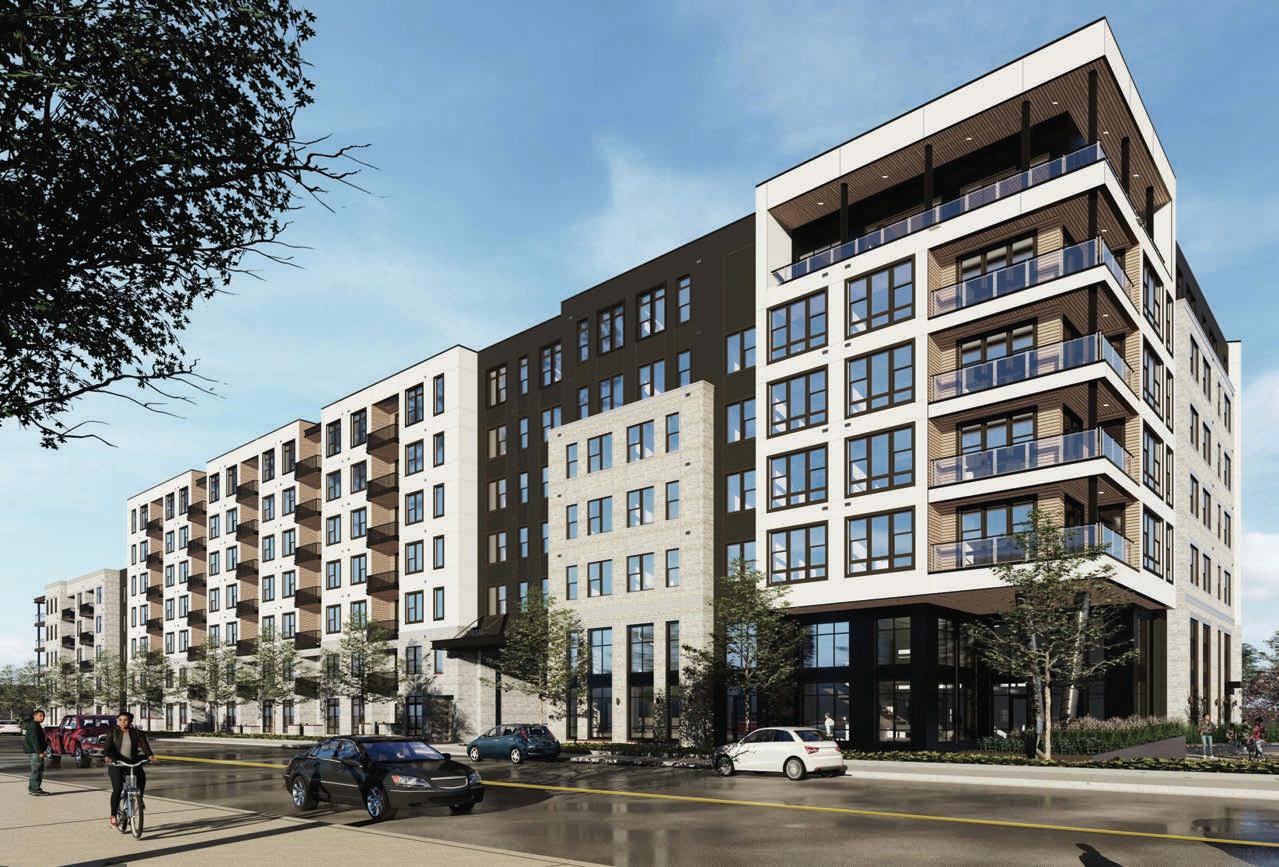
Other characteristics that contribute to a high quality of life range from Nashville’s music scene to Tampa’s Gulf Coast beaches, from Charlotte’s relative proximity to the Blue Ridge Mountains to Orlando’s relative proximity to the Florida coastlines. People are attracted to all five metros for their warmer winter climates, as compared to northern metros.
The most significant quality of life characteristic may be the lower cost of living in EMBREY’s eastern markets. Paychecks go further in EMBREY’s eastern markets than in the higher-cost coastal markets. Many workers who can work fully from home have relocated to EMBREY’s metros due largely to their lower costs.
4
SOUTHERLY AT LOSO | Charlotte, NC | 8 |
The lower cost of living theoretically means that renters can move into homeownership sooner than in higher-cost metros. However, for-sale house prices have appreciated significantly over recent years. Moving into homeownership is not as easy as is often perceived in these markets. Renters are staying in rental housing longer, thereby helping to maintain high levels of multifamily demand.
In the 12 years since house values troughed after the Great Financial Crisis, U.S. home values have appreciated at an average annual rate of 7.0%. In EMBREY’s eastern markets, house prices have been rising faster. Tampa and Orlando had the largest increases, both with double-digit annual gains.
( FIGURE 5 ).
The stabilization or slight downturns in house values experienced over the past few quarters have done little to make for-sale housing more affordable. From Q3 2022 to Q1 2023 the House Price Index for the five eastern markets fell only 1.3% on average. Q1 2023 house prices were still higher than the prior year by an average of 5.0%. High mortgage rates have exacerbated the situation — currently averaging 6.7% compared to 3.1% at the end of 2021.
Homeownership rates also confirm that a large percentage of households cannot or choose not to buy homes in EMBREY’s eastern markets. Homeownership rates in Nashville, Tampa, and Charlotte are only slightly higher than the U.S. while homeownership rates in Raleigh and Orlando are lower than the national average.
INVESTOR APPEAL: EMBREY’S EASTERN MARKETS ATTRACT INVESTORS
Strong investor appetite reflects a market’s favorable property market fundamentals and outlook. Additionally, elevated investor interest translates to greater access to capital for development or acquisitions and greater security of selling assets at favorable pricing or, in other words, strong liquidity.
For many years, U.S. multifamily investment has favored high-growth metros including EMBREY’s five eastern markets. Investment activity in 2023 is down significantly everywhere due to the capital markets environment — highe r borrowing costs, lower availability of capital, asset pricing uncertainty, and elevated recession risk — and capital is generally sitting on the sidelines. But, when the capital markets environment improves — likely beginning in the second half of 2023 — keen interest in the high-growth markets should return.
FIGURE 5
HOME PRICE APPRECIATION & HOMEOWNERSHIP
U.S. 176 390 7.0 65.9 Charlotte 159 429 8.8 66.1 Nashville 195 555 9.3 69.4 Orlando 141 445 10.2 62.4 Raleigh 181 426 7.5 64.7 Tampa 170 579 11.0 67.2 METRO INDEX Q3 2022 HOUSE PRICE INDEX INDEX Q2 2011 AVERAGE ANNUAL INCREASE (%) HOMEOWNERSHIP RATE (%) 5 | 9 |
SOURCE: EMBREY Partners; Rice Economics, LLC; U.S. Federal Housing Finance Agency, U.S. Census Bureau (homeownership average for Q2 2022 through Q1 2023). HPI, 100 = Q1 1991; Q2 2011 represents the HPI bottom following the GFC.
In the past five years, multifamily investment in EMBREY’s eastern markets totaled more than $100 billion or 9% of all U.S. investment over the period.
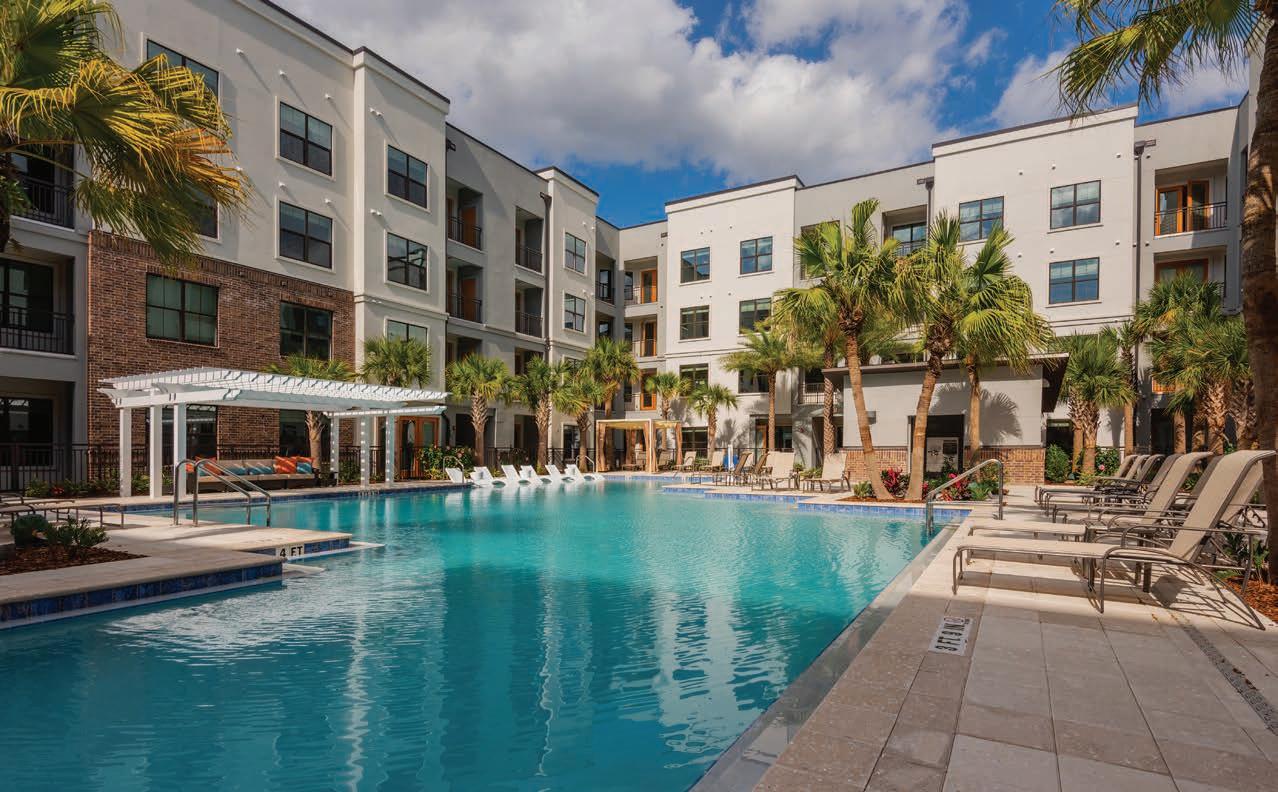
Strong investment interest in EMBREY’s five eastern markets is reflected in the 2018-2022 acquisitions total of $107 billion or 9.2% of the national total ( FIGURE 6 ). All of EMBREY’s eastern markets ranked among the top 20 in the country for total 2018-2022 investment. Orlando and Charlotte led the group, ranking 13th and 14th nationally.
Cap rates also reflect levels of investment appetite and market liquidity. Since mid-year 2022, multifamily cap rates have been inching up across the U.S. due primarily to the capital markets dislocation. However, over the previous decade, cap rates declined steadily across the U.S. reflecting greater interest in the asset class generally and less perceived risk.
FIGURE 6
MULTIFAMILY INVESTMENT IN EASTERN EMBREY MARKETS, PAST FIVE YEARS
U.S. 1,166.3 -Eastern EMBREY Markets 107.2 9.2Charlotte 23.2 2.0 14 Nashville 17.2 1.5 20 Orlando 25.7 2.2 13 Raleigh 20.2 1.7 17 Tampa 21.0 1.8 16 METRO INVESTMENT 2018-2022 ($B) PERCENT OF U.S. TOTAL U.S. RANK
SOURCE: EMBREY Partners; Rice Economics, LLC; MSCI, Inc. Rank out of 41 metros.
| 10 |
CANNERY AT THE PACKING DISTRICT | Orlando, FL
Cap rate contraction in EMBREY’s eastern markets has been more pronounced than most markets. Since 2019, cap rates in all the eastern markets have averaged at or below the national average. The average of the eastern markets fell nearly two percentage points to 4.4% (for all classes of apartments) from 2013 to 2022. The 2022 average was lowest in Raleigh (4.1%) and highest in Tampa (4.5%), but all under the U.S. average of 4.7% ( FIGURE 7 ).
7
FIGURE 7
HISTORICAL MULTIFAMILY CAP RATES EMBREY EASTERN MARKETS
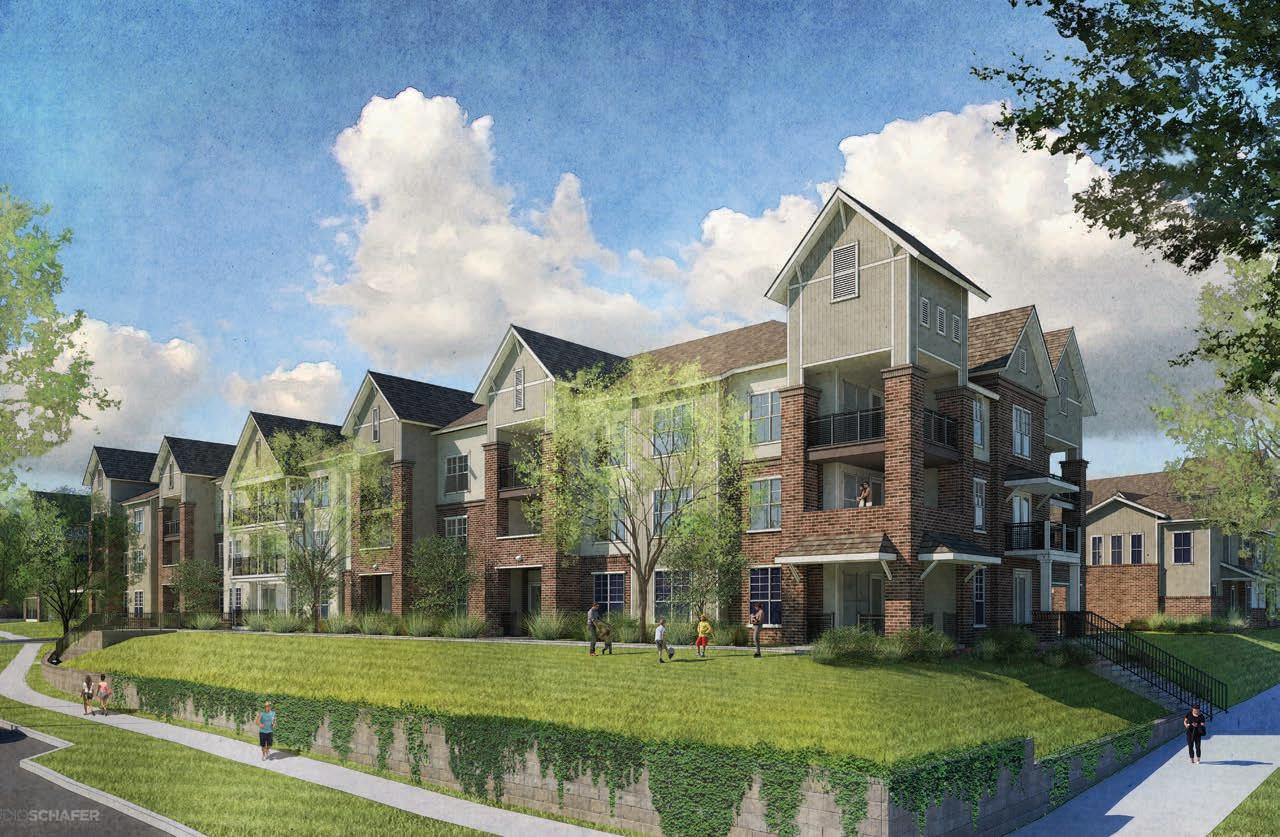
HISTORICAL MULTIFAMILY CAP RATES IN EASTERN EMBREY MARKETS
Over the past decade, cap rates in EMBREY’s eastern markets have declined farther and faster than the national average.
HUNTERSVILLE, NC | 11 |
HEARTWOOD AT VERMILLION |
SOURCE:
EMBREY Partners; Rice Economics, LLC; MSCI, Inc. FIGURE
: EMBREY Partners; Rice Economics, LLC; MSCI, Inc. 4.0 4.5 5.0 5.5 6.0 6.5 7.0 2013 2014 2015 2016 2017 2018 2019 2020 2021 2022 U.S. Eastern Markets Average
SOURCE
ADDITIONAL FLAVOR AND EMBREY INSIGHTS ON INDIVIDUAL EASTERN MARKETS
Each of EMBREY’s five eastern markets has its own set of characteristics over and above the general trends discussed above. EMBREY’s development leaders provided more perspective on these as well as development challenges and strategies in each eastern market.
NASHVILLE. Nashville has long been known for its music entertainment and business, especially country music. Other industries like health care administration, auto manufacturing, and logistics have been part of its economic fabric for multiple decades. A unique business advantage for Nashville is that the metro is in the Central time zone but is still relatively close to the Atlantic Seaboard for logistics and distribution purposes. Nashville’s transformation into one of the most exciting and dynamic diversified economies in the country — and a metro that young adults are attracted to — occurred relatively quickly beginning about a decade ago.
The large corporate expansions of Amazon and Oracle into Nashville — announced in 2018 and 2021, respectively — brought considerable and well-deserved attention to Nashville. Emerging Trends , the preeminent annual outlook report produced by Urban Land Institute and PriceWaterhouseCoopers, named Nashville the top U.S. metro for commercial real estate in 2023.
For a metro of its size — smallest of the five eastern metros with 2.0 million people — Nashville is impressive in that it has two teams in the four major professional sports organizations: Tennessee Titans (NFL) and Nashville Predators (NHL). Nashville also has an MLS team (Nashville SC) that began play in 2020.
EMBREY continues to look for development opportunities in the vibrant urban core — likely podium or wrap design — but the market for sites is very competitive and the high levels of development in the urban core may lead to temporary market softness. The best opportunity is suburban garden and build-to-rent (BTR) development. The most promising areas include along I-65 around Franklin and Spring Hill to the south, around Gallatin to the northeast, and around Lebanon and Mt. Juliet to the east.
Nashville has a few unique development challenges including its varied topography coupled with solid bedrock increasing construction costs. Moreover, Nashville is a small metro by population and not particularly close to any larger metros. Atlanta is the closest at 250 miles southeast. Therefore, the availability of construction subcontractors and services is less deep than found in larger markets.

| 12 |
ORLANDO. Orlando does not typically receive headline-level corporate expansions, but the metro is a “jobs machine” and, contrary to perception, a high percentage of service sector jobs pay quite well. Orlando’s largest private employer continues to expand. In April, Disney announced plans to invest $17 billion in Disney World attractions and improvements over the next decade, although current political disputes may lead to delays or reduction in the investment total.
Lockheed Martin is an important employer with more than 10,000 workers at two large campuses, including one by the main campus of University of Central Florida in east Orlando. UCF is an economic generator itself with 68,442 students (fall 2022) and about 12,000 employees. It is the largest university in Florida and one of the largest in the country. In addition to defense-related high tech, gaming and virtual reality technology activity is expanding in Orlando.
Beyond jobs, Orlando’s appeal includes the warm weather and relative proximity to both of Florida’s coasts — one hour to east, two hours to west. Orlando is well known nationally and attracts newcomers based partly on their wonderful childhood memories from family visits here. Orlando has one major league sports franchise, Orlando Magic (NBA), plus the Orlando City SC (MLS).
One economic challenge of Orlando is that it competes with Tampa located about two hours southwest downtown to downtown. Tampa is larger and has a more dynamic central business district and more established popular infill neighborhoods. It has Gulf Coast beaches within the urbanized area. That said, one of Orlando’s strengths and advantages over Tampa is its central location in Florida which has benefited Orlando’s logistics and distribution activity. Note that one of the fastest growing areas of Florida and the country is Lakeland — 2022 population of 787,000 — the small metro situated between Orlando and Tampa. Development from both metros is spilling into Lakeland, and Orlando and Tampa are economically growing closer together.
In Orlando, EMBREY’s primary strategy is developing suburban garden and BTR product. While urban growth is occurring in nearly all directions, it is particularly rapid in the southwest, making that part of Orlando appealing for development, including Lake County. Additionally, EMBREY was very successful with its inaugural Packing District community — The Cannery at The Packing District, just north of downtown — and would consider developing another community here.

THE HARPER | Franklin, TN
| 13 |
Rents in EMBREY’S eastern markets are projected to rise 3.3% in 2023.
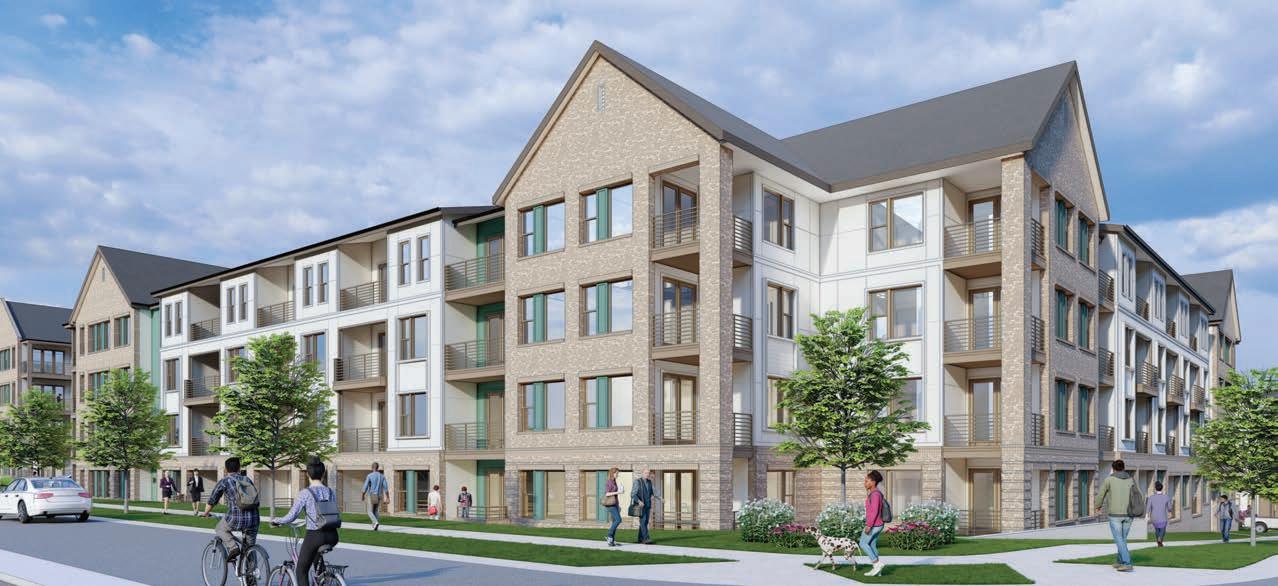
TAMPA. At 3.2 million people, Tampa is the largest of EMBREY’s eastern metros and has a wide array of urban amenities given its size. One of these is professional sports, including the Tampa Bay Buccaneers (NFL), Tampa Bay Rays (MLB), and Tampa Bay Lightning (NHL). Tam pa is also a center for baseball spring training and has five minor league baseball teams (including one based in Lakeland). People are attracted to Tampa also for its warm climate as well as its large array of beaches and water-related recreation.
While EMBREY’s Central Florida activity is currently focused on Orlando, the development strategy for the near future includes both infill and suburban development in Tampa. The best Tampa areas for suburban garden and BTR product include Pasco County to the north, south Hillsborough County and Manatee County toward, Sarasota along the Gulf Coast southeast of Tampa. For infill midrise product, Westshore is of particular interest.
CHARLOTTE. Charlotte has a well-defined urban core and well-established popular neighborhoods. People are attracted to Charlotte for its climate — warmer than in northern metros, but still offering four seasons — and the ability to reach both mountains and sea in a morning’s drive — within three hours to Blue Ridge Mountains and within four to Atlantic coast beaches. Charlotte has very strong air service with many more domestic and international air connections than most metros its size which is very important for both residents and corporations considering expansion. Charlotte has two major professional sports enterprises: Carolina Panthers (NFL) and Charlotte Hornets (NBA), plus the Charlotte FC (MLS). The latter is a soccer expansion team which began play in 2022. Charlotte hosts many NASCAR events and is a secondary headquarters for the car-racing company after Daytona.
Charlotte is a generally pro-growth metro with municipal agencies that are more predictable and organized than most for the entitlement process. Charlotte has encouraged high-density development to help increase housing stock. One development challenge is water and sewer infrastructure. The infrastructure’s capacity has not kept pace with growth, and limits site availably.
LoSo (Lower South End), NoDa (North Davidson), and University City (by University of North Carolina Charlotte) are three areas that are attractive to EMBREY for higher-density development even if very competitive given the large amount of new product built in recent years. Some of the more promising suburban areas for garden development include the I-77 corridor north of Charlotte, particularly from Huntersville to Lake Norman. EMBREY also likes the development potential in the South Carolina suburbs on the southern side of the metropolitan area.
FINLEY ON THE GREEN | CHARLOTTE, NC
| 14 |
RALEIGH. Raleigh has been one of the most dynamic metros in the U.S. for several decades due largely to the large concentration of high-technology industries here. Raleigh’s high-tech story began in earnest with the creation of the Research Triangle Park as far back as the 1950s. Today, the Park has about 65,000 workers and 300 organizations including the National Institutes of Health, GlaxoSmithKline, and Cisco Systems — its second largest campus in the U.S. Eli Lilly is currently building a $920 million expansion to its local drug manufacturing facility. Raleigh’s economic strength and growth are also derived from its highly educated population.
Similar to Charlotte, quality of life features include relative proximity to the Atlantic coast — two hours to Wilmington, N.C. or 3½ to the Outer Banks. Raleigh has one major professional sports team: Carolina Hurricanes (NHL).
Many residents feel that the Raleigh metro still offers a comfortable small-town feel, likely due to the metro’s unique geography. It is structured around three central cities rather than one — Raleigh, Durham, and Chapel Hill. The unique geography provides some challenges to understanding the metro’s growth patterns and identifying the best areas for multifamily development. Watershed protection rules add another layer of complexity to development in Raleigh.
When the time is right for EMBREY’s expansion into Raleigh, EMBREY will look for both infill development opportunities as well as suburban garden and BTR opportunities.
MARKET PERFORMANCE TODAY AND 2023 OUTLOOK
Driven by high levels of household growth and rental housing demand, EMBREY’s five eastern multifamily markets have performed well over recent years. While high amount of new supply is putting some shortterm downward pressure on performance, the outlook for the years to come is generally favorable for the same reasons that created demand in the past.
In late 2022 and early 2023, market fundamentals returned to more normal performance after the previous 1½ years of peak demand and dramatic rent gains. Q1 2023 statistics reveal stable occupancy levels and moderating rent growth — 4.8% year-over-year based on effective rents.
In 2023, multifamily completions in the five eastern EMBREY markets are projected at 63,000 units compared to 2022’s total of 37,138. Combined, the new supply represents an elevated 5.7% increase to the existing inventory, double the national average and much higher than historically experienced in the eastern markets. The large volume of 2023 deliveries is of concern in four of the five eastern markets: Charlotte, Nashville, Orlando, and Raleigh.
Howe ver, net absorption is also projected to rise to impressive levels this year and mitigate potential market softening due to new supply. EMBREY’s eastern markets should remain some of the most robust in the country. RealPage projects net absorption to total 52,200 units in the five eastern EMBREY markets. Charlotte ranks seventh highest in the U.S. for projected net absorption. Nashville, Raleigh, and Orlando rank 11th, 12th, and 14th, respectively.
Dynamic markets with active construction pipelines typically have lower occupancy levels than less active markets. This is true for EMBREY’s eastern markets where occupancy levels are averaging one-half point under the national average of 95%. The outlook for 2023 is for a modest softening of occupancy from Q1’s 94.3% to Q4’s 94.0%.
Nationally, multifamily rents are projected to rise by 3.1% in 2023, well below 2022’s 6.6% and 2021’s 13.9%, but on par with the historical average. Similarly, rent growth in EMBREY’s five eastern markets is expected to average a respectable 3.3% in 2023, with the range from 2.7% in Nashville to 4.5% in Charlotte.
| 15 |
conclusion
EMBREY’s five eastern markets have been leaders for population and economic growth for many decades. Their expansion rates have far surpassed the country as a whole and most other metros in the U.S. Sustained growth in Charlotte, Nashville, Orlando, Raleigh, and Tampa has created consistently high levels of multifamily demand, favorable market performance, and development opportunity. In addition, over recent years, multifamily investment in EMBREY’s eastern markets has been particularly robust.
In the years to come, these markets will continue to be magnets for in-migration and economic expansion. Their rates of growth will substantially outpace national levels. Continued expansion of diverse high-tech industries will fuel some of the growth along with quality of life factors, particularly lower living costs than in Mid-Atlantic and Northeastern metros. The long-term demand outlook for multifamily housing is very favorable and will help to create additional and diverse development opportunities for EMBREY over the next decade.
FIGURE 8
MULTIFAMILY MARKET SUMMARY, EASTERN EMBREY MARKETS
U.S. 18,957,100 549,700 2.9 470,100 94.8 95.0 1.96 1,782 3.1 Eastern EMBREY 1,111,500 63,000 5.7 52,200 94.3 94.0 1.77 1,695 3.3 Markets Percent of U.S. 5.9 11.5 11.1 Charlotte 217,200 16,500 7.6 15,300 93.9 94.1 1.65 1,582 4.5 Nashville 176,300 13,000 7.4 11,400 94.3 94.5 1.72 1,638 2.7 Orlando 260,400 13,600 5.2 10,700 94.8 94.1 1.86 1,803 2.8 Raleigh 182,000 12,700 7.0 11,100 93.8 93.9 1.59 1,537 2.8 Tampa 275,600 7,200 2.6 3,700 94.4 93.6 1.95 1,823 3.6 METRO NEW SUPPLY TO INVENTORY RATIO (%) COMPLETION 2023 FORECAST SUPPLY / DEMAND INVENTORY OCCUPANCY EFFECTIVE RENT UNITS Q1 2023 DEMAND 2023 FORECAST CHANGE 2023 FORECAST (%) MONTHLY RENT ($) Q1 2023 RENT PSF Q1 2023 Q4 2023 FORECAST Q1 2023 | 16 |
SOURCE: EMBREY Partners; Rice Economics, LLC; RealPage. Forecasts as of Q1 2023. Data based on communities with 50+ units.
ARTICLE AUTHOR: JEANETTE I. RICE, CRE RICE ECONOMICS, LLC.
Ms. Rice is one of the country’s leading multifamily economists. She is the founder of Rice Economics, LLC, a consulting firm providing real estate economics and business consulting for commercial real estate firms.

Prior to Rice Economics, LLC, Ms. Rice was Americas Head of Multifamily Research for CBRE, the largest multifamily debt and equity intermediary in the U.S. At CBRE, Ms. Rice covered nearly all aspects of the U.S. multifamily property and capital markets. She was a frequent speaker at industry events and wrote hundreds of white papers and research briefs on the sector. Her more notable white papers included: The Case for Workforce Housing; The Single-Family Built-to-Rent Housing Sector; The Way Forward - Path to Urban Multifamily Recovery; Global Outlook 2030 - Multifamily; and U.S. Multifamily Primer for Offshore Investors.
Ms. Rice began her career in the multifamily sector. One of her first positions was with EMBREY Investments where she conducted feasibility analysis for prospective developments and provided investment strategies for EMBREY ’s geographic expansion in the 1980s. Following EMBREY , Ms. Rice held research leadership positions with HFF (now part of JLL), Lend Lease Real Estate Investments, Crescent Real Estate Equities, and Verde Realty.
Ms. Rice has been involved with many professional organizations through her 40-year career. In particular, she has been active with the National Multifamily Housing Council for many years. She is a Counselor of Real Estate and has held numerous leadership positions with the Counselors of Real Estate organization.
Ms. Rice earned a B.A. in history from the University of Washington and M.A. in urban geography from Queen’s University in Canada. She also completed two years of graduate coursework in urban geography at The University of Chicago. Ms. Rice is a 40-year Texas resident, currently based in Fort Worth.
| 17 |
ABOUT EMBReY
EMBREY is a fully integrated real estate investment, acquisition, development, construction and management firm focused on creating maximum value for our partners. EMBREY ’s strong performance over nearly half a century demonstrates the value created by disciplined investing and a keen eye for detail.

49+ YEARS IN BUSINESS
5,400+ UNITS UNDER CONSTRUCTION
$1B+ CURRENT ANNUAL DEVELOPMENT PRODUCTION
$756MM EQUITY CURRENTLY MANAGED
46,300+ MULTIFAMILY UNITS DEVELOPED







11,000+ UNITS UNDER MANAGEMENT

| 18 |
SAN ANTONIO, TX DALLAS, TX PHOENIX, AZ HOUSTON, TX ORLANDO, FL AUSTIN, TX CHARLOTTE, NC DENVER, CO NASHVILLE, TN

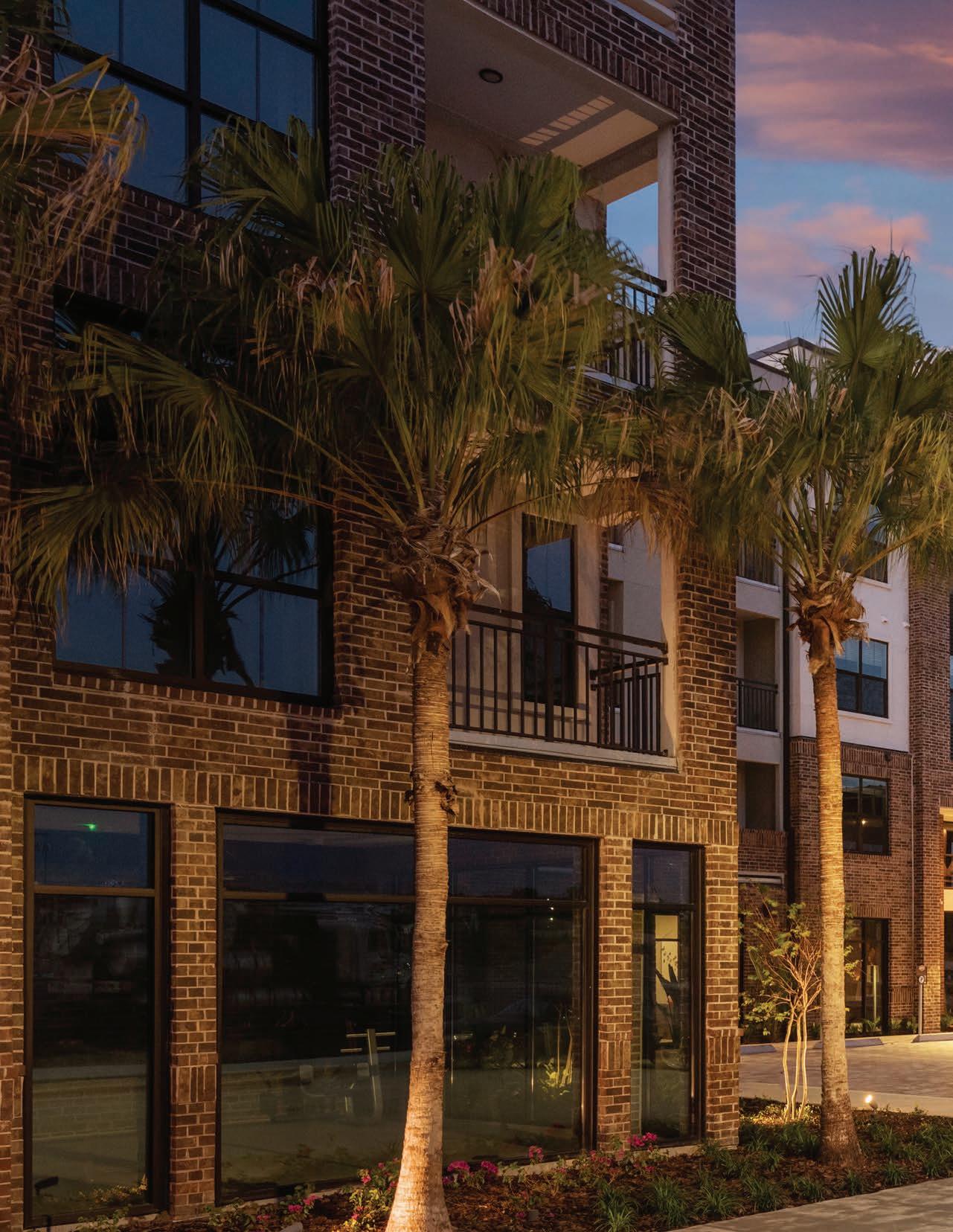

7600 Broadway, Suite 300 San Antonio, TX 78209 EMBREYDC . com



 FIGURE 2
FIGURE 2
 FIGURE 3
FIGURE 3


















